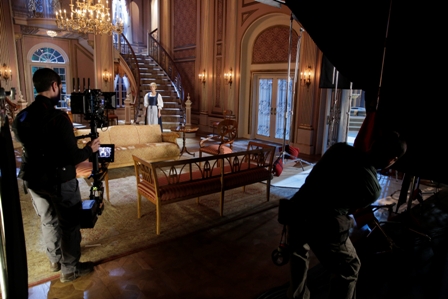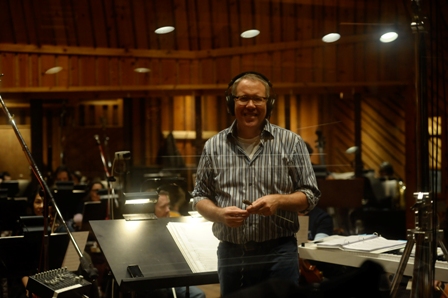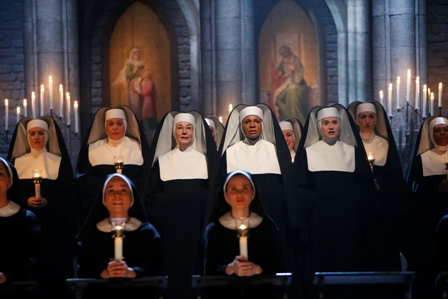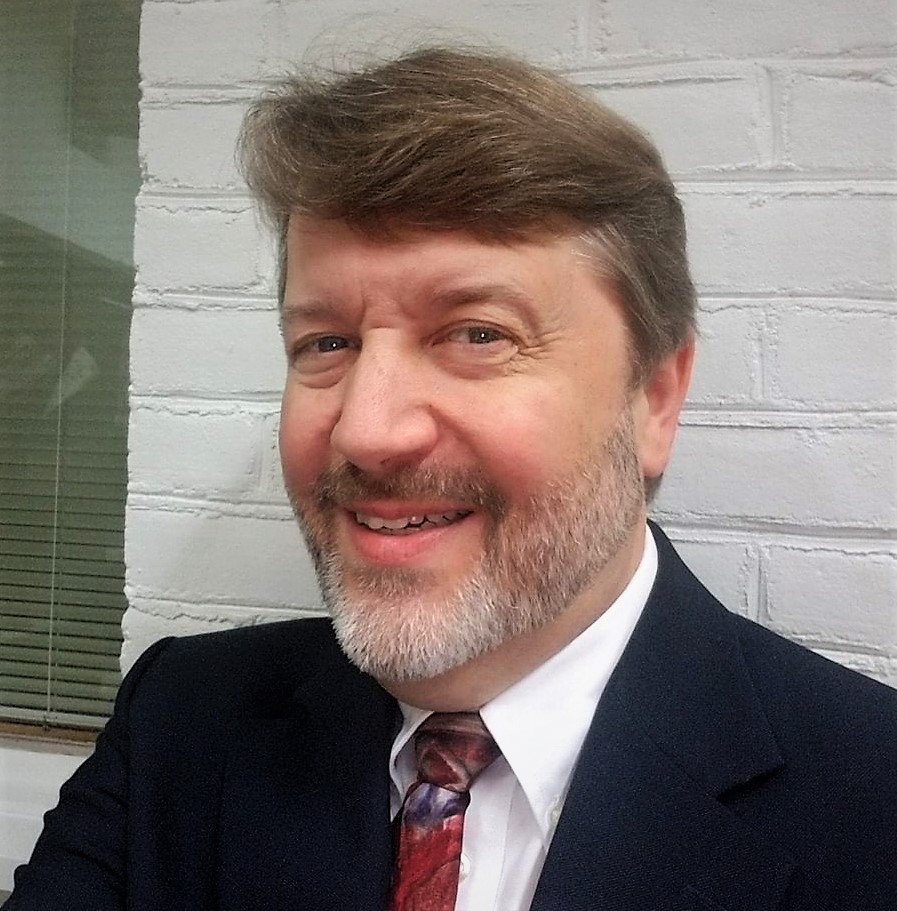Sound of Music: On Stage, On the Small Screen
NEW YORK—NBC’s live broadcast of the Rodgers & Hammerstein classic “The Sound of Music” last month did more than garner high ratings. It also served as a testament to the challenges involved in elaborate live stage productions—a type of program little seen on national television over the past 50 years.

A cameraman follows Carrie Underwood on "The Sound of Music Live!" set. The crew that set up, rehearsed and pulled off “The Sound of Music Live!” wanted to “create a hybrid, a live TV broadcast that looked like a movie, with no audience,” according to Robert Dickinson, the production’s lighting designer.
They’ve deemed it a success with few noticeable glitches, despite the pressure of a primetime, three-hour, major network broadcast—that was the first live broadcast of a Broadway stage show since CBS aired “Cinderella,” starring Julie Andrews, in 1957.
The challenges at hand were daunting, not the least of which turned out to be that so many million sets of eyeballs (18.5 million the night of the show, with 38.2 million having seen some portion of it since the initial broadcast), were focused on their local NBC stations that night, for a show that was presented by a 300-plus cast and crew from Grumman Studios in Bethpage, N.Y.
While the production was criticized in some circles, given some issues with the sound mix, for instance, the production made history.
“Without question, it represents a new genre of live TV broadcasts,” said Dickinson. “From a designer’s perspective, to do something without current precedent is quite a thrill.”
SHOOTING SPACE
The crew started rehearsing together in late October in two of Grumman’s (the birthplace of the Apollo lunar modules) seven studios, building six sets on 39,000-square-foot Studio 3. It also rented Studio 2 for hair, makeup and placing mics on the actors.
Twelve Sony HDC-2500s were used throughout: seven were on pedestals, including four with Fujinon 22 x 7.2 lenses, the other three with Fujinon 27 x 6.5s; then three on Steadicams and two were on TechnoJibs, with all five cameras using wide-angle Fujinon 13 x 4.5s. In addition, each lens was fitted with a .5 GlimmerGlass filter, with the cameras shot at 30 psf (instead of 24p) to “make the shot look a little less crisp,” said Director Beth McCarthy.
Given the use of the dozen cameras on the set during the live (aside from the orchestral elements of the music) show, the utmost care had to be taken to ensure that nothing—like a crew member tripping over a cable and possibly pulling a plug in doing so—bad happened.
“The cabling, believe it or not, was just the usual 500-foot rolls,” said Bob Muller, the broadcast’s supervising technical director. “What was unusual is that all of the cameras were wired,” [though about 62 Shure RF mics, with 15 BTR wireless mic systems, were also part of the production].
“Using 12 wired cameras was challenging, because we had to block one scene at a time, then move the cameras we were using for the next scene without disconnecting any of the others,” Muller added.
Pulling and reconnecting the plugs wasn’t an option. “We couldn’t disconnect them,” he said, “because you run the risk that a camera might not come back up.”
IN THE MIX
As for blocking off shots, utilities “did a great job,” Muller said. “As the scenes were blocked, they were making diagrams of which camera would be used for each scene, then positioned. Then they figured out which camera would be moved first or second, to prevent the cables from getting tangled.”
Also in the equipment mix—much of it included in All Mobile Video’s 53-foot HD Double-Expando Epic truck—were two 6-channel EVSs, an Avid DekoCast for the opening titles and (scantly used) animation, and a Sony MVS-8000 switcher. The show was mastered on SR and each camera was “iso’ed” on HDCAM, with scenes dumped to a Cinedeck for NBC to upload into the PIX System.
“That was akin to uploading dailies for NBC’s West Coast executives,” Muller said, noting another challenge was the production’s use of 6.5 megawatts of power from several Aggreko generators for the broadcast.
As for the music mix, Klaus Landsberg, the senior production mixer, discussed the biggest challenges in working on the hybrid production that included so many open mics.

David Chase, music director for "The Sound of Music Live!"
“I was basically handling the sound mix in a room that wasn’t built with TV production in mind,” Landsberg said of Grumman, noting the use of Cedar DNS1500s to quell the ambient sound, some of which came from fans on some of the almost 1,000 moving lights, with more than 1,700 instruments used for the show, total.
“Remember, there hadn’t been a live Broadway show on network TV in more than 50 years, when boom mics [which were available, just in case, as was a keyboard player in case ProTools failed, etc.] were common,” Landsberg said. “For this production, I was told that no mics were to be seen on the air.”
To achieve that end, the sound crew employed those 62 Shure U1 and U1 Micro wireless mics very carefully, along with a Studer Vista 8 digital console with five digital layers. Also in the mix were DPA 4061 capsules.
The unusual surroundings meant that Landsberg had to address situations a mixer usually wouldn’t have to. “We even had to watch for things like sounds echoing off of the habits of the nuns,” he said. “Generally, I don’t like adding to any sounds because, when you add frequencies, the sounds start getting tinny and jumps out at you, especially dialogue.
“So,” he said, “it’s better to just carve off the frequencies in that range so everything sounds natural.”
RISK PAYS OFF
Mark Weglinski, the audio playback engineer, worked with the QLab, a digital audio playback system that is typically used on Broadway. “It’s reliable and gives letter- perfect cues,” he said, “so fades and cross fades were pre-programmed, and let us play them back exactly as they were rehearsed.”

"The Sound of Music Live!" was produced by a 300-plus crew on a soundstage on Long Island.
The actual interface for the playback system was a Berringer X-32 console, a fairly new piece of technology. “Understanding that Berringer has not always had the best reputation in the business, it performed well during the production,” said Weglinski. “It made my job easier.”
With the QLab, he had primary and redundant rigs, both with 16 channels. “The mixer allowed me to switch seamlessly between the primary and backup in the event of a technical malfunction, but there were none,” he said. “Everything happened the way it was supposed to.”
True, more than one crew member commented that it was amazing that the production took exactly three hours (“We were within a half-second,” said Muller) and there were no major issues. Between that happy news and the ratings, NBC execs are discussing plans to produce another musical.
“By and large, the few mistakes made were human and, if anyone noticed them, just reminded the viewer that the show was live,” said Dickinson. “It was the challenge, as well as the genius, of the producers, who could have easily shot a movie over two months and broadcast it. They took a big risk. And won.”
Get the TV Tech Newsletter
The professional video industry's #1 source for news, trends and product and tech information. Sign up below.
Mark R. Smith has covered the media industry for a variety of industry publications, with his articles for TV Technology often focusing on sports. He’s written numerous stories about all of the major U.S. sports leagues.
Based in the Baltimore-Washington area, the byline of Smith, who has also served as the long-time editor-in-chief for The Business Monthly, Columbia, Md., initially appeared in TV Technology and in another Futurenet publication, Mix, in the late ’90s. His work has also appeared in numerous other publications.

